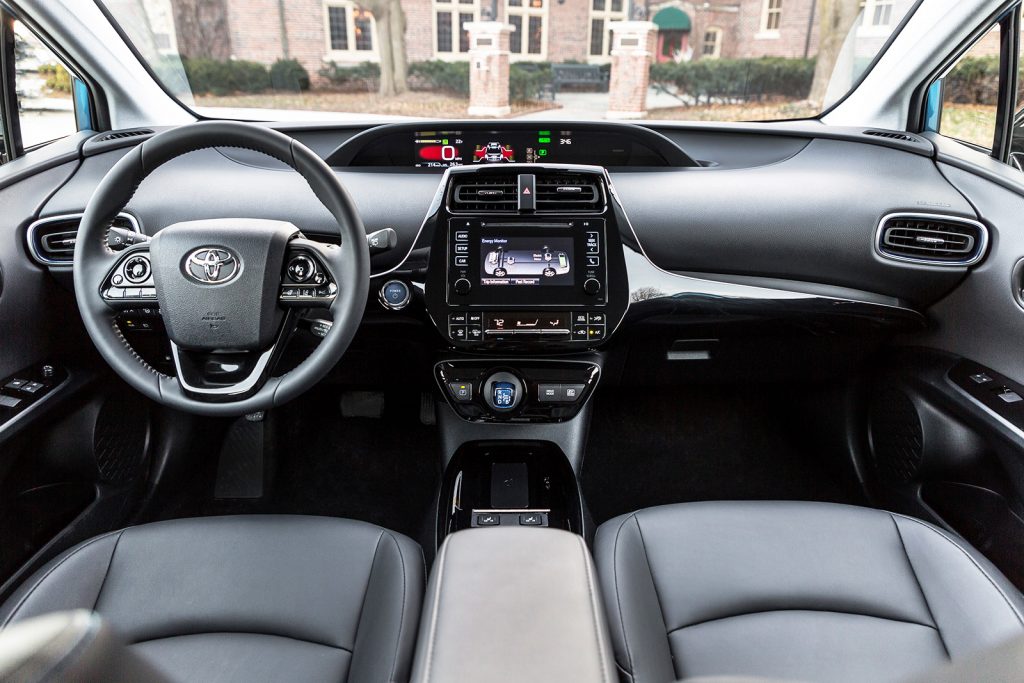Cargazing
By Derek Price
Toyota is trying to change that with the introduction of an all-wheel-drive version of the Prius hybrid.
The federal government rates the new, all-weather Prius — called the AWD-e — at 52 mpg in city driving and 48 on the highway. While that’s a 2 mpg penalty compared to the ordinary, front-wheel-drive Prius, it’s also dramatically better than most other cars that send power to all four wheels.
The Prius joins a chorus of sedans that are making AWD versions available this year, presumably because of the dramatic consumer shift toward crossover vehicles. Selling a sedan with better traction gives buyers one less reason to dump the traditional American family car for a brawny SUV.

The Toyota Prius’ familiar shape covers something new: an all-wheel-drive system that delivers better traction in rainy or icy weather.
In places where snow, rain and ice are common, AWD vehicles can be big sellers. That’s why there’s a newly available AWD version of the Mazda3 (33 highway mpg) and Nissan Altima (36 highway mpg), for example. And Subaru has been capitalizing on the benefits of all-wheel traction for years, leading to immense popularity in New England and the Pacific Northwest.
The new Prius is a good fit for people who need go-anywhere capability without the Earth-hating stigma and added fuel expense of an SUV.
Assuming you can look past its unusual styling, both inside and out, the current Prius is fairly mundane to drive. It wears its environmentalism on its sleeve with the classic hybrid shape and very digital-focused cabin, but it feels very similar to a normal gas-powered vehicle from the driver’s seat.
The ride is comfy and seating reasonably spacious, something that still surprises me every time I open the door and realize how big it is compared to how it looks in pictures.
The same thing applies to its cargo area. The Prius offers 27.4 cubic feet of volume in back, which compares favorably with a lot of small crossovers and SUVs. Fold the seats down, and a whopping 65.5 cubic feet is available for hauling stuff — again, a remarkable number for a car that looks small in pictures.
While the AWD-e version is the biggest and most surprising change, Toyota made several revisions to the Prius for the 2019 model year.

The Prius’ cabin is impressively roomy for both passengers and cargo capacity. It feels bigger than it looks in pictures.
It looks slightly different, for starters. It has a new look in front and back, including an all-new front bumper and a fresh style for its headlights and taillights. Inside, there are two more USB ports, a bigger wireless charging station for cell phones and a standard heated steering wheel on its higher-end trims.
The trim levels are changing, too, to fit in with the more typical Toyota naming scheme. Gone are the numeric trims for the Prius, replaced by the ascending L, LE, XLE and Limited grades that Toyota buyers already know.
It also comes standard with Toyota Safety Sense-P, a package that includes radar cruise control, steering assist to keep you centered in the lane, pedestrian detection and automatic high beams.
Pricing starts at $23,770 for the front-wheel-drive L Eco grade and climbs to $28,820 for the all-wheel-drive XLE loaded with luxury and convenience features. The fancy Limited grade, only available in front-wheel drive, tops the lineup at $32,200.
At A Glance
Wheelbase: 106.3 in.
Length: 180 in.
Width: 69.3 in.
Height: 58.1 in.
Powertrain: 1.8-liter four-cylinder engine and two electric motors (121 combined system horsepower)
Transmission: Continuously variable
Fuel economy: 52 city, 48 highway
RATINGS
Style: 7
Performance: 8
Price: 8
Handling: 6
Ride: 7
Comfort: 8
Quality: 9
Overall: 8
It remains one of the most fuel-efficient cars on the road, even when you opt for the extra traction of all-wheel drive.
